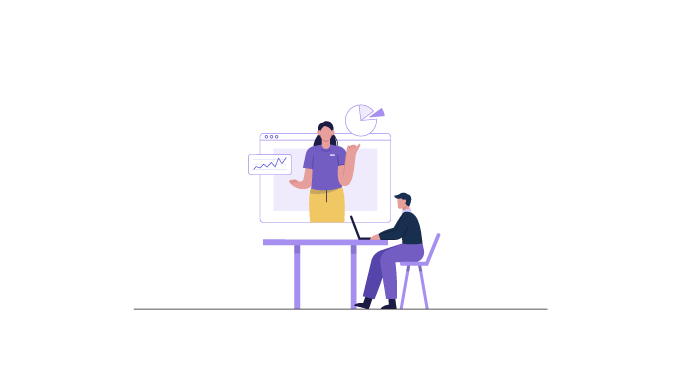The Ultimate Guide To Employee Development In 2024
When you hear the phrase "employee development," many questions pop into your head.
What is it? Why is it necessary? How does it help your business objectives?
You might not know the answers to these questions, but one thing is certain. You cannot afford to ignore employee development to keep your star employees.
Let's deconstruct employee development and the benefits it brings for an easier understanding.
What is Employee Development?

Employee development is the process of adding to the existing skills and knowledge through various employee development programs to support the organization's goals. Usually, firms put in place human resource management to increase growth. Moreover, doing so helps sustain a workable system with competent employees.
Employees are the building blocks of every company. To improve your company's profit margin, invest in your employees' skills and abilities. Suppose you are looking at the "how-to" part. In that case, it is all about offering a mix of training, eLearning, student aid support, etc.
Why is Development Important to an Employee?

Change is said to be the only constant in this world. If we take this as the stature, we cannot condone stagnation. To avoid stagnation, we have to evolve and develop through all the available means. And with the ever-changing corporate world, the development of employees has become even more crucial. Zoe Sharan, a leadership development coach, industry speaker, and HR of Amicus recently shared some critical insights on how learning and development have become significant over time.
In my experience, learning and developmental programs have evolved significantly with time. They once were an ideal-to-have. They are now a business imperative. I believe this is because, in L&D, we no longer assign learning goals. Instead, our L&D solutions assign program effectiveness goals that are measured by their ability to deliver business results. So, learning and developmental programs are essential for activating the company strategy through people which is significant.
Most companies use employee surveys to accurately determine
Keeping this in mind let us investigate how employee development is important for both the employees and the employers.
Benefits for Employees:
Learning and developmental programs offer employees valuable opportunities for personal and professional growth. By participating in these programs, employees can acquire new skills, enhance their knowledge, and advance their careers. This not only boosts their confidence and job satisfaction but also opens doors to new opportunities for advancement within the company.
When employees feel supported in their growth and development, they are more likely to feel engaged and motivated in their roles. This sense of investment in their future fosters a deeper sense of loyalty to the company and increases their overall job satisfaction.
Benefits for Employers:
Investing in learning and developmental programs demonstrates a commitment to employee growth and well-being, which can significantly impact retention rates. When employees feel valued and supported in their professional development, they are more likely to stay with the company long-term, reducing turnover costs and ensuring continuity in the workforce.
Furthermore, employees who participate in ongoing learning and development are better equipped to meet the evolving needs of the business. They bring fresh ideas, innovative thinking, and enhanced skills to their roles, driving productivity, efficiency, and ultimately, business success.
What are the Four Approaches to Employee Development?

Employee Development is not a one-way street. You have several options for how you want to support the development of your employees.
Here are a few of the most effective approaches:
1. Formal Education
Like everything else in life, education has become very expensive. Offering tuition reimbursement can help your company attract and retain talent. This can be highly beneficial, especially in a talent war.
According to a study conducted by AdAssist:
84% of employees cited tuition assistance as an important factor in joining their companies. 71% of participants rated tuition assistance among the best benefit offered by their employers after healthcare.
Allowing employees to continue their education can help them develop their careers. Further education opportunities are always attractive. There are many options for providing employees with educational opportunities like:
Online Courses
Flexible and self-paced, online courses empower employees to learn at their convenience, covering a wide range of topics relevant to their roles and aspirations.
Workshops and Seminars
Led by industry experts, these interactive sessions provide hands-on learning experiences, fostering collaboration and innovation among employees.
Tuition Reimbursement Programs
Offering financial support for further education, these programs demonstrate a commitment to employee growth, attracting top talent and encouraging career advancement.
Companies that provide employees with the same are likely to attract top talents. These employees are likely to be more motivated to work. And ambitious employees can improve the company's human resources.
2. Assessment
Constant study or work without assessment is like putting someone out to sea on a raft without paddles. You will be floating around without any direction or land in sight.
Regular assessments from peers, managers, and customers help assess employees' strengths or weaknesses. The evaluation needs to be shared with the assessed employee for the appraisal to be effective. The study results can help the company develop training courses to help employees improve themselves.
Just as a ship needs a compass to sail smoothly, regular assessments provide employees with direction in their professional journey. These assessments offer valuable insights, guiding individuals towards growth and success in the workplace.
Performance Reviews
Performance reviews provide clear insights into employees' strengths and areas for improvement, guiding their professional growth by setting actionable goals aligned with organizational objectives.
360-Degree Feedback
360-degree feedback offers a well-rounded perspective on employees' performance, promoting self-awareness and accountability while guiding them to refine their skills and interpersonal effectiveness.
Self-Assessment Tools
Self-assessment tools empower employees to evaluate their own performance, identify learning opportunities, and set meaningful goals for continuous improvement, fostering a culture of self-directed learning and development.
3. Mastering Through Experiences
Experience is the mother of knowledge. An employee with more job experience tends to be better at handling problems than one with more degrees. This is because a degree often does not translate to practical problem-solving.
Getting hands-on experience not only provides employees with knowledge but also practical how-to. This fact makes job experience a very vital part of the development of employees. Other strategies to improve that experience include options like
Transfers:
Moving employees to different roles or departments within the organization, allowing them to gain new skills, perspectives, and experiences while contributing to the overall success of the company.
Promotions:
Recognizing and rewarding employees for their exceptional performance and potential by promoting them to higher-level positions with increased responsibilities and opportunities for growth.
By leveraging digital platforms equipped with innovative recognition solutions, organizations can streamline the promotion process and ensure that employees receive the acknowledgment and appreciation they deserve.
Job rotations or Shadowing:
Providing employees with opportunities to temporarily work in different roles or shadow experienced colleagues, allowing them to learn new skills, expand their knowledge, and gain a deeper understanding of various aspects of the business.
Stretch Assignments:
Assigning employees challenging tasks or projects that are beyond their current scope of responsibilities, encouraging them to step out of their comfort zone, develop new competencies, and demonstrate their potential for future growth.
Mentorship Programs:
Pairing employees with experienced mentors who provide guidance, support, and advice, helping them navigate their career paths, overcome challenges, and develop professionally and personally.
4. Building Connections: The Power of Interpersonal Relationships
Professionally taught courses aren't the only way to learn. Interacting with coworkers and superiors can have a big impact on career growth.
Developing such social skills (soft skills) is just as crucial as having hard skills. Employees with patience, empathy, and integrity can take the entire team to new heights.
Coaching:
Coaching involves one-on-one guidance and support provided by a skilled coach to help employees identify their strengths, weaknesses, and areas for development. Through regular sessions, coaching helps individuals set goals, develop action plans, and overcome obstacles, ultimately enabling them to reach their full potential and achieve their career objectives.
Networking Opportunities:
Networking opportunities involve providing employees with platforms and events to connect with colleagues, industry professionals, and mentors. These opportunities allow individuals to expand their professional network, exchange ideas, seek advice, and explore potential career paths. By building meaningful relationships and connections, employees can access new opportunities, gain valuable insights, and advance their careers within and beyond the organization.
These approaches to the improvement of employees are followed by the stages involved in the employee lifecycle model.
Crafting Success: Building a Winning Employee Development Plan
Identifying Employee Development Needs
Assessing employees' current skills, knowledge, and areas for improvement to determine specific areas of focus for development.
Setting SMART Goals and Objectives
Establishing clear, specific, measurable, achievable, relevant, and time-bound goals that align with employees' development needs and organizational objectives.
Developing a Personalized Development Plan
Creating a tailored plan outlining the strategies, resources, and activities needed to achieve the identified goals and objectives.
Implementing the Plan: Putting Knowledge into Action
Executing the development plan by providing employees with access to training, mentoring, coaching, and other learning opportunities.
Evaluating and Measuring Results: Tracking Progress and Impact
Assessing the effectiveness of the development plan by monitoring employees' progress, collecting feedback, and measuring the impact of their development efforts on their performance and the organization's success.
Additional Tips for Effective Employee Development
Aligning Development with Business Goals: Building a Synergistic Approach
Ensure that employee development initiatives are directly aligned with the organization's strategic objectives, promoting synergy between individual growth and overall business success.
Fostering a Culture of Continuous Learning: Making Development a Way of Life
Promote a culture where learning and development are valued and encouraged regularly, fostering an environment where employees are empowered to continuously improve and grow.
Encouraging Feedback and Evaluation: Embracing the Power of Improvement
Create opportunities for employees to provide and receive feedback on their development progress, fostering a culture of openness, collaboration, and continuous improvement.
Cultivating a Learning Environment: Creating a Space for Growth
Establish a supportive and inclusive environment where employees feel comfortable taking risks, experimenting with new ideas, and embracing opportunities for growth and development.
In Conclusion
A company's continued growth relies on employees since they are the core structure supporting its growth. The development of these employees is directly proportional to the company's growth. The long-term goal of the company should focus on developing its employees. It should aim to provide them with opportunities for growth and a good work-life balance.


















